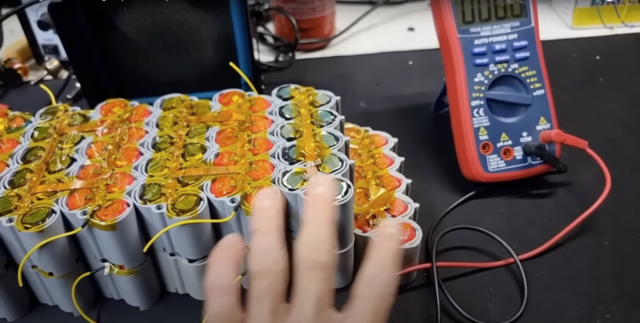Disposable vapes are indefensible. Many, or maybe most, of them contain rechargeable lithium-ion batteries, but manufacturers prefer to sell new ones. More than 260 million vape batteries are estimated to enter the trash stream every year in the UK alone. Vapers and vape makers are simply leaving an e-waste epidemic to the planet’s future residents to sort out.
To make a point about how wasteful this practice is—and to also make a pretty rad project and video—Chris Doel took 130 disposable vape batteries (the bigger “3,500 puff” types with model 20400 cells) found littered at a music festival and converted them into a 48-volt, 1,500-watt e-bike battery, one that powered an e-bike with almost no pedaling more than 20 miles. You can see the whole build and watch Doel zoom along trails on his YouTube video.

A pile of empty aluminum
A pile of empty aluminum vape shells, and the juice and batteries that came out of them, on Chris Doel’s workstation.
A pile of empty aluminum

Chris Doel
Vape batteries, put into group cases, wired together in batches, and then wired in serial into two stacks, next to a multimeter.
Chris Doel

Chris Doel
How the battery fits onto the bike that Chris Doel powers with vape batteries: a big bag, ratchet straps, and wiring to a rear hub motor. Just, one more time, folks: do not do this at home.
Chris Doel
Vape batteries, put into group cases, wired together in batches, and then wired in serial into two stacks, next to a multimeter.
Chris Doel
How the battery fits onto the bike that Chris Doel powers with vape batteries: a big bag, ratchet straps, and wiring to a rear hub motor. Just, one more time, folks: do not do this at home.
Chris Doel
To be clear: Do not do this. Do not put disposable vape cartridges in a vise clamp to “pop out” their components. Do not desolder them from vape cartridges that have a surprising amount of concentration still in them. Do not wire them together using a balance board, group them using 3D-printed cell holders, and then wire them in series. Heck, do not put that much power into a rear hub on a standard bike frame, at least more than once. Doel has a fire extinguisher present and visible on his workbench, and he shows you what happens when two of the wrong batteries happen to make momentary contact—smoke, coughing, and strong warnings.
And yet, when you see Doel get 33 kilometers (about 20.5 miles) on his vape-powered ride, almost entirely without pedaling, hitting 32 miles per hour once, the point is made. We are tossing out a lot of battery materials that could be doing a lot of other things. Doel estimates his “dodgy bike” cost about $60 in filament and materials to piece together. Most of the cells are rated for a minimum of 300 cycles, which is both not a lot, but also more than some bikes and scooters actually take on.

